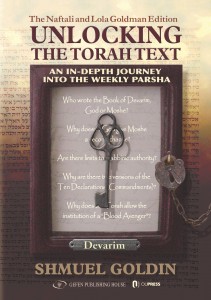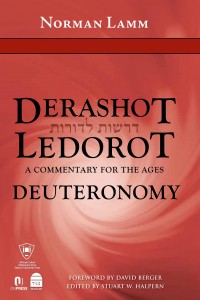Excerpted from Rabbi Dr. Norman J. Lamm’s Derashot Ledorot: A Commentary for the Ages – Deuteronomy, co-published by OU Press, Maggid Books and YU Press; edited by Stuart W. Halpern
An Unforgettable Devar Torah*
Memory and forgetfulness are subjects for study by psychologists, neurologists, and cyberneticists. It is for them to learn and explain the “how” of these processes, the mechanisms and the dynamics.
But these two themes are also the substance of spiritual life. Many Torah commandments refer to remembering and forgetting. We are commanded to remember, amongst other things: the Sabbath, the day we left the Land of Egypt, what the Lord did to Miriam (and, thus, the teaching that no one is infallible), how we angered the Lord in the desert, and, to be aware of our own penchant for ingratitude.
Similarly, there are commandments concerning forgetfulness. Most prominent is the commandment of shikheĥa (Deuteronomy 24:19) – that if one has harvested his field and forgotten a corner, he must not return to it but leave that forgotten corner for the poor. Even more paradoxical is a commandment to forget (although it is not worded explicitly in that manner). We must forget grudges, insults, hurt: “You shall not take revenge, you shall not bear a grudge” (Leviticus 19:18). Forgetfulness is even considered a blessing. The Talmud (Pesaĥim 54b) teaches: “It is ordained that the dead be forgotten from the heart.” Rabbenu Bechaye has pointed out that this is a great blessing, for if man were always to remember the dead, he soon would be laden with such grief that he could not survive emotionally or spirituality.
But most often, and most usual, forgetfulness is regarded as an evil, as a sin. Thus, the Rabbis taught (Avot 3:8), “If one forgets a single item from his studies, Scripture considers it as if he were guilty with his life.”
And, of course, the source of all these commandments is the concluding portion of our sidra: Remember what Amalek, that barbaric and savage tribe, did to you… “You shall not forget” (Deuteronomy 25:17).
But this commandment not to forget is problematic. After all, everyone forgets. Forgetting is natural; it is part of both our psychological and physiological selves. It is not a volitional or deliberate act. How, then, can the Torah consider it a sin if we forget?
Permit me to recommend to you an answer suggested by Rabbi Yitzchak Meir Alter, the first Gerrer Rebbe, known to posterity by the name of his great halakhic work, Ĥidushei HaRim. Forgetfulness, he says, often depends upon man. For we are not speaking here of simple recollection of facts, but the kind of forgetfulness that implies the emptying out of the mind, the catharsis of the heart of its most basic spiritual principles, of the very props of its identity. And this kind of forgetfulness has its roots in arrogance.
When a person’s mind is preoccupied with itself, it has little place for what is really important – and thus forgets it. Hence we read (Deuteronomy 8:14): “And your heart shall be lifted up, and you will forget the Lord your God who takes you out of the Land of Egypt, out of the house of slaves.”
Similarly, we are commanded to remember and not to forget Amalek. Now, the numerical value of the Hebrew word Amalek is 240 – the very same numerical value as the word ram, the word we use when we say that the heart is being lifted, raised, exalted, supercilious! When a person is filled with conceit, he falters and forgets.
Too much ego results in too little memory. An absent mind is the result of a swelled head. A high demeanor results in a low recall. If your heart is arrogant, you will forget Amalek. This is the arithmetic of mind and character.
Indeed, this potential for forgetting who we truly are is a human, if not a specifically Jewish, weakness. Rabbi Abraham Isaac Kook has taught us that the root of all evil is that we forget who we are, our higher selves. We turn cynical and act as if man is only an amalgam of base drives, of ego-satisfactions, of sexual and material grasping. We forget that, in addition, man is capable of noble action, of sublime sentiment, of self-sacrifice. When we forget that, we are in desperate trouble.
Most Jews who assimilate today, unlike those of the early and middle parts of this century, do not do so primarily because of self-hatred, but because of a massive act of ethnic forgetfulness. And such national absent-mindedness, of forgetting our higher identity, is often the result of “And your heart shall be lifted up.” Our memory is weakened by excessive affluence and too much self-confidence. We American Jews act as if our liberties and successes are self-evidently our right. We act as if our good fortune is deserved. And so, “And your heart shall be lifted up,” leads to “and you will forget the Lord your God.” And what do we most often forget? Amalek!
I read recently that a Swedish gentile woman, who has several times been proposed for the Nobel Peace Prize because of the hundreds of Jews she saved during the Nazi occupation, said in an interview that only once in her life did she entertain hatred for a fleeting moment. It occurred during a visit she paid to Yad Vashem, the Holocaust museum, in Jerusalem. She noticed an American Jew who was there, and who said to the guide: “I don’t understand why they didn’t fight? Why weren’t they real men?” She was seized with anger, and said to him: “You look fat and prosperous! Have you ever been hungry a day in your life? Do you have any idea what it is like to be starved almost to insanity, surrounded by powerful enemies, aware that no one in the world cares for you – and you have the unmitigated nerve to ask that question?”
I confess that in reading the interview, I shared her hatred – but only for a fleeting moment. One cannot hate fools. One can only have contempt for them.
Certainly, we are subject to that weakness of forgetting time and again. Only a year ago Israelis – and Jews throughout the world – were afflicted by over-confidence, and the Yom Kippur War was the result. I should hope that we Jews are bright enough to have learned from this experience.
Most importantly, one of the things we must never dare to forget is the contemporary Amalek, the Holocaust. The news that the younger generation of Germans does not want to be reminded of it, that they feel they did not participate in it, comes as no surprise to me. But Jews must never fall into the trap of “And your heart shall be lifted” and hereby forget Amalek. Remember and do not forget! The Holocaust must constantly become part of our education, commemoration, and motivation for further study and spiritual development.
Conversely, if we remember Amalek, that will lead to a realistic assessment of ourselves, and we shall be able to avoid the pitfall of a “lifted heart.”
The United States and the entire Western world are today in the doldrums. We are, all of us, in a pessimistic mood about the economy, something which affects each and every one of us. If the Lord helps, and we all escape economic disaster, then perhaps we will have learned to rid ourselves of the cultural and psychological and moral signs of decadence in our culture, all these corruptions the result of “And your heart shall be lifted,” over-confidence inspired by affluence.
So, the Ĥidushei HaRim has given us an unforgettable devar Torah about forgetfulness and arrogance.
It is a lesson worthy of our deep thought and meditation.
Remember it. Do not forget.
* August 31, 1974







